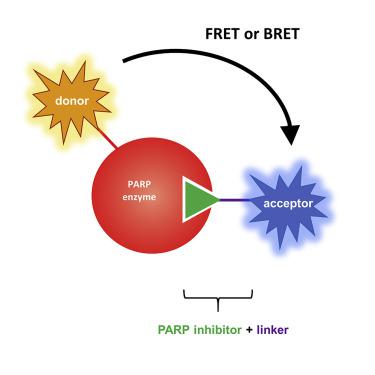Cell Chemical Biology ( IF 8.6 ) Pub Date : 2020-07-16 , DOI: 10.1016/j.chembiol.2020.06.009 Tim J Wigle 1 , Danielle J Blackwell 1 , Laurie B Schenkel 1 , Yue Ren 1 , W David Church 1 , Hetvi J Desai 1 , Kerren K Swinger 1 , Andrew G Santospago 1 , Christina R Majer 1 , Alvin Z Lu 1 , Mario Niepel 1 , Nicholas R Perl 1 , Melissa M Vasbinder 1 , Heike Keilhack 1 , Kevin W Kuntz 1

|
Poly(ADP-ribose) polymerase (PARP) enzymes use nicotinamide adenine dinucleotide (NAD+) to modify up to seven different amino acids with a single mono(ADP-ribose) unit (MARylation deposited by PARP monoenzymes) or branched poly(ADP-ribose) polymers (PARylation deposited by PARP polyenzymes). To enable the development of tool compounds for PARP monoenzymes and polyenzymes, we have developed active site probes for use in in vitro and cellular biophysical assays to characterize active site-directed inhibitors that compete for NAD+ binding. These assays are agnostic of the protein substrate for each PARP, overcoming a general lack of knowledge around the substrates for these enzymes. The in vitro assays use less enzyme than previously described activity assays, enabling discrimination of inhibitor potencies in the single-digit nanomolar range, and the cell-based assays can differentiate compounds with sub-nanomolar potencies and measure inhibitor residence time in live cells.
中文翻译:

用于研究PARP酶靶标结合的体外和细胞探针。
聚(ADP-核糖)聚合酶(PARP)酶使用烟酰胺腺嘌呤二核苷酸(NAD +)修饰一个单单(ADP-核糖)单元(PARP单酶沉积的MARylation)或支链聚(ADP-核糖)聚合物(PARP多酶沉积的PARylation)。为了开发用于PARP单酶和多酶的工具化合物,我们开发了用于体外和细胞生物物理测定的活性位点探针,以表征竞争NAD +结合的活性位点抑制剂。这些检测方法无法识别每种PARP的蛋白质底物,从而克服了这些酶在底物周围普遍缺乏的知识。在体外 与以前描述的活性测定相比,该测定使用的酶更少,可区分单位数纳摩尔范围内的抑制剂效价,而基于细胞的测定可区分具有亚纳摩尔效价的化合物,并测量抑制剂在活细胞中的停留时间。



























 京公网安备 11010802027423号
京公网安备 11010802027423号